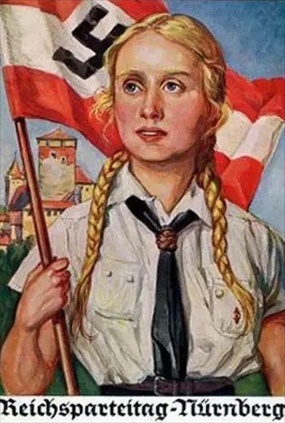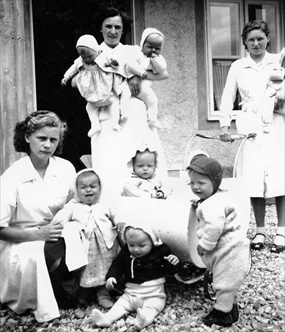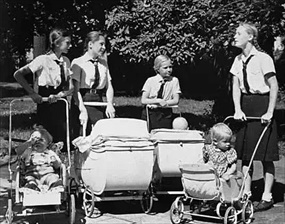GERMAN GIRLS MUST ENROLL IN HITLER YOUTH PROGRAM
Berlin, Germany • December 1, 1936
On April 20, 1930 (Adolf Hitler’s 41st birthday), the League of German Girls (Bund Deutscher Maedel, abbreviated BDM) was founded in Germany. It was the female wing of Hitler’s Nazi Party youth organization, the Hitler Youth (Hitlerjugend, abbreviated HJ), whose origins dated to 1922 under several different names. Recruitment in the BDM and HJ jumped beginning this date, December 1, 1936, with the passage of the Law Concerning the Hitler Youth (Gesetz ueber die Hitlerjugend). The law required all eligible German citizens of either gender living within the borders of the Third Reich to enroll in one or the other youth branch or its junior affiliate. Exceptions were briefly made for Catholic youth. Girls had to be at least 10 years old to enroll in the junior version of the BDM and, like boys, had to be free of “hereditary diseases.” Not until 1939 did membership in the parallel youth programs become fully compulsory. After that the 2 programs became the only legal organizations in which German youth could belong.
In both youth branches, the leaderships’ intention was to indoctrinate their charges in the tenants of Nazi Party ideology, especially German nationalism and theories about conflict between superior (“Aryan” or Nordic) and inferior (Untermenschen) races. The Nazis lumped Jews and Slavs (i.e., eastern Europeans like Poles and Russians) in the subhuman category. The importance of self-sacrifice for the Fatherland and loyalty to the Fuehrer (national leader) was front and center. But boys and girls also wanted fun so there were camping, campfire sing-alongs, swimming, hiking, horseback riding, track and field sports, gymnastics, lessons on flying, sailing, skating and skiing, and so on. Of particular focus in the BDM was training females for their roles in German society: obedient wife, mother, and homemaker. “If a German girl must choose between marriage or a career,” declared Magda Goebbels, wife of Minister of Propaganda and Enlightenment Joseph Goebbels, “she will always be encouraged to marry, because that is what is best for a woman.” The League also strongly warned girls to avoid Rassenschande, or racial defilement.
The oversize role members and graduates of these 2 youth organizations played in the Third Reich in the 1930s to the cataclysmic end of Hitler’s totalitarian dictatorship in May 1945 is truly remarkable. During the 12 years of a highly militarized society, roughly 20 million German youth wore a uniform of one kind or another. The paramilitary Reich Labor Service (Reichsarbeitsdienst, RAD), divided into separate sections for men and women ages 18 to 25, worked to mitigate the effects of unemployment on the German economy and in so doing helped militarize the workforce and indoctrinate workers in Nazi ideology and core values (see photo essay). During the war years, compulsory labor service brought more young women into the RAD, and the organization developed an auxiliary unit to support the Wehrmacht armed forces.
In the last year of war a half-million women auxiliaries were in the Wehrmacht (Wehrmachtshelferinnen), serving in the army (Heer), air force (Luftwaffe), and navy (Kriegsmarine). About half were volunteers; the other half performed obligatory service connected to the war effort (Kriegshilfsdienst). They were assigned duties both inside the Third Reich and inside German-occupied Poland, France, Yugoslavia, Greece, and Romania. Females were telephone, telegraph, and radio operators, also administrative clerks, typists, messengers, and stenographers. In military health service they served as volunteer Red Cross nurses. By late 1944, the Luftwaffe flak artillery corps listed 160,000 female personnel. On the darker side, as civilian employees of the SS (Schutzstaffel, the Nazi Party’s “Protective Squadron”), these SS Gefolge served as camp guards and nurses in death and concentration camps. Some women became members of the sinister Waffen (Armed) SS (SS Hilferinnen).
The League of German Girls (BDM) During the Hitler Years, 1922–1945
 |  |
Left: As required by Landfrauenjahr (a year of rural service), 18‑year-old girls from the Berlin chapter of the League of German Girls gather in the hay harvest in this photograph from September 18, 1939. Girls billeted in a Landjahrlager or with farm families performing both farm and domestic chores. This same photo was repurposed in May 1942. The caption in the propaganda magazine Das Deutsche Maedel (May 1942 issue) read: “Bringing all the enthusiasm and life force of their youth, our young daughters of the Reich Labor Service make their contribution in the German territories ‘regained’ in the East.” “Regained in the East” was a reference to the Polish territories Nazi Germany annexed after September 1, 1939, when Hitler declared war on his eastern neighbor, Poland. Compulsory Reich labor service in the RAD was a half-year for men and women. Many BDM girls were sent to occupied Poland to “Germanize” ethnic Germans who were resettled there from further east. The girls were placed under SS supervision.
![]()
Right: Young women of the League of German Girls practicing gymnastics in 1941. Dictators like Hitler discovered that sports and gymnastics could be converted from sources of recreation and entertainment to a means to an end: physically strong and tough, highly patriotic and motivated soldiers or, put less delicately, cannon fodder. That’s exactly what thousands upon thousands of German youth at ever younger ages who were impressed into the Wehrmacht and Volkssturm (home guard) became in the late stages of World War II. It’s been estimated that 100,000 Hitler Youth perished in the last months of the war. During the Battle of Berlin from April 16 to May 2, 1945, Hitler Youth were a significant part of the Nazis’ last-ditch, suicidal defenses.
 |  |
Left: Nazi propaganda photo: a radiant mother, her radiant daughters, and her radiant son attired in a Hitler Youth uniform pose for the February 1943 edition of SS-Leitheft (SS Lead Booklet), a Nazi periodical from 1934 to 1945. Translated into Norwegian, Danish, Flemish, Dutch, and Estonian, the periodical circulated among professional officers in the SS, the uniformed elite corps and self-described “political soldiers” under the leadership of Reichsfuehrer‑SS Heinrich Himmler.
![]()
Right: Blonde girl in twin braids (Zoepfe) wearing the uniform of the League of German Girls and holding the flag of the Hitler Youth. The drawing was used as a poster for the Nazis’ 10th Party Congress, named the “Rally of Greater Germany” (Reichsparteitag Grossdeutschland), September 5–12, 1938, which celebrated Austria’s Anschluss (union) with Nazi Germany. The girl’s image against the backdrop of old town Nuremberg, minus the text, was a popular postcard.
 |  |
Left: League of German Girls 1938 poster: “All ten-year-olds [belong] to us.” By 1936, under the Jugenddienstpflicht (formally, Law Concerning the Hitler Youth) the Hitler Youth had enrolled 5.4 million youngsters aged 10–18. Rival youth groups—whether political, religious, or simply associational—disbanded, were banned, or were swept into the Nazi Party’s collective organizations, which were based on a military model of squads, platoons, and companies. By 1939 Hitler Youth membership comprised 90 percent of the country’s youth, up from 60 percent in 1935. The prophesy of the young girl in the poster had proven nearly correct.
![]()
Right: League of German Girls 1938 poster: “Build [HJ] youth hostels and homes” says this fresh-faced, smiling “can rattler.” BDM girls were encouraged to become involved in community service projects, national welfare and charitable fund-raisers, political activities, and other activities that their leadership considered advanced National Socialism (Nazism) and helped build a great and prosperous New Germany. Activities included collecting donations of money, gathering clothing for Winter Relief (Winterhilfe) and knitting socks, stationing themselves at train stations where injured soldiers or refugees needed assistance, visiting bedridden soldiers in hospitals, laying out and tending small vegetable and fruit gardens (equivalent to “victory gardens”), etc.
 |  |
Left: Females were seen as the “incubators” of Germany’s future soldiers, as housekeepers and child rearers. Motherhood was sacrosanct in Hitler’s Germany, but a marital relationship between a man and a pregnant woman was not required. German women were encouraged, even rewarded, for giving birth to large numbers of children, even illegitimate ones. The government provided financial incentives and nurseries and childcare at no cost. Prolific child bearers were awarded special medals: the Honor Cross of the German Mother (Mutterkreuz) with Bronze for more than 4 children, Silver for more than 6, and Gold for 8 or more. In the 5 months between December 1939 and May 1940, a total of 121,853 Honor Cross Gold medals were awarded during the annual Mothering Sunday (elsewhere Mother’s Day), celebrated on the second Sunday of May.
![]()
Right: During the war years members of the League of German Girls volunteered to take children from large families to the park while the mothers of infants were at work. This domestic service was the flipside of Landfrauenjahr or the mandatory RAD youth labor service, both described above.
League of German Girls, a Documentary
![]()

 History buffs, there is good news! The Daily Chronicles of World War II is now available as an ebook for $4.99 on Amazon.com. Containing a year’s worth of dated entries from this website, the ebook brings the story of this tumultuous era to life in a compelling, authoritative, and succinct manner. Featuring inventive navigation aids, the ebook enables readers to instantly move forward or backward by month and date to different dated entries. Simple and elegant! Click
History buffs, there is good news! The Daily Chronicles of World War II is now available as an ebook for $4.99 on Amazon.com. Containing a year’s worth of dated entries from this website, the ebook brings the story of this tumultuous era to life in a compelling, authoritative, and succinct manner. Featuring inventive navigation aids, the ebook enables readers to instantly move forward or backward by month and date to different dated entries. Simple and elegant! Click 











